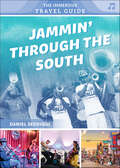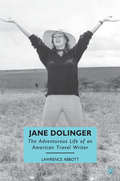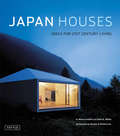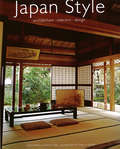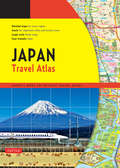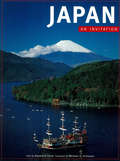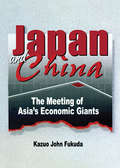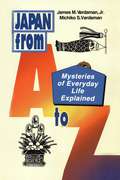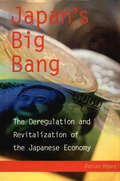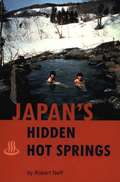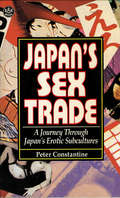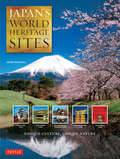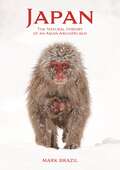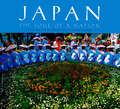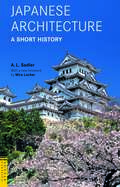- Table View
- List View
Jammin' Through the South: The Immersive Travel Guide (The\immersive Travel Guide Ser. #1)
by Daniel SeddiquiMany genres of music—including the blues, bluegrass, country, rock and roll, and gospel—have roots in the American South, and the region has nurtured some of the world's most famous and talented musicians—from Dolly Parton and Loretta Lynn to Elvis Presley and B.B. King. Seddiqui—dubbed "the Most Traveled Person in America"—leads readers on an experience-based travel journey through the music of the South. The curated itinerary features • stops in Lexington, the hollers of eastern Kentucky, Bristol, Pigeon Forge, Nashville, Memphis, the Mississippi Delta, New Orleans, Lafayette, Houston, and Austin; • fun, hands-on learning opportunities—from taking a line-dancing class to hand-crafting an instrument—that allow travelers to experience firsthand the music that flows through the region; • interviews with noted makers and musicians who provide insight into the region's craft and music traditions; and • information on lodging and other attractions that travelers should be sure not to miss as they jam their way through the South.
Jane Austen: Her Homes and Her Friends
by Constance Hill Ellen G. HillOn a sunny September morning more than a century ago, a horse and buggy bearing two sisters wound its way past green pastures and wooded hills to the narrow streets of a Hampshire village. Constance and Ellen Hill, a pair of passionate admirers of Jane Austen, sat prepared to take the first steps in retracing the life of their idol. This charmingly written and illustrated account of their literary pilgrimage begins in Steventon, Jane Austen's birthplace, and extends to Bath, Lyme, Southampton, London, and elsewhere before concluding at the author's burial place in Winchester Cathedral. Along the way, it offers insights into the connections between the author's experiences and those of the characters in her novels. <P><P> Constance and Ellen Hill were given access to manuscripts of Austen's letters, unpublished family memoirs, and notebooks containing the "Minor Works," as well as the loan of family portraits, pictures, and contemporary sketches. Their fascinating glimpse of Austen's world, originally published in 1902, abounds in the same enthusiasm that draws Janeites to the author. "The more intimate their knowledge of her character becomes," the Preface promises readers, "the more must they admire and love her rare spirit."
Jane Dolinger
by Lawrence AbbottFor almost forty years, Jane Dolinger traveled the world and wrote about her adventures, from the Amazon jungle to the sands of the Sahara. She produced eight books and more than a thousand articles between 1955 and 1995, and she also earned a reputation as a glamorous celebrity and model. Jane Dolinger was an anomaly in her time, a dynamic and attractive woman with an impressive literary talent, a woman who lived and documented a most unconventional and inspirational life. Sometimes controversial but always outstanding, Jane was a pioneer among women and writers. Here for the first time, her life and work are studied in a thoroughly researched yet entertaining literary biography.
Japan Country Living
by Amy Slyvester Katoh Shin KimuraFrom Japanese antiques to home and garden design, Japan Country Living is a delightful introduction for art and furniture lovers. In over 400 full-color photographs of quaint country homes, lush gardens, simple decorations and traditional dishes and recipes, the lifestyle of the Japanese countryside as it was yesterday can be found in this book. This book lets readers visit charming Japanese country homes and gardens and discover a lifestyle that has been handed down for centuries.
Japan Home: Inspirational Design Ideas
by Noboru Murata Lisa Parramore Chadine Flood GongWhether you're remodeling your house, redesigning your apartment or just looking for a book of design ideas, Japan Home is a beautiful and indispensable resource full of practical information, shopping resources and inspiration.<P><P>Japanese interior design has long been renowned for its spare beauty, utility and grace. Today, more and more people outside Japan are incorporating Japanese features in their homes and gardens as they come to appreciate the way in which materials, colors, patterns and shapes are interwoven in a uniquely light and evocative way.Japan Home, lavishly illustrated with full-color photos and packed with practical information, is the perfect source for anyone eager to find ways to decorate or enhance their home with that special Japanese flair. The authors explore ways to create typical Japanese spaces both inside and outside the home that are tranquil yet dramatic, understated yet elegant. All designs are enriched with the distinct Japanese aesthetic.
Japan Houses: Ideas for the 21st Century
by Geeta K. Mehta Marcia Iwatate Takeshi NakasaThis Japanese architecture and design book is a wonderful source of new styles and ideas for those looking to add a distinctively Zen flair to their home.<P><P>Limited spaces, unlimited technology, a tradition of innovation, and sheer Japanese panache have combined to inspire the 26 stunning homes featured in Japan Houses. Conceived by 24 of Japan's leading architects and designers, each of the houses forecasts and defines a new trend in residential architecture, reinventing the meaning and use of space, material, and function.Traditional lifestyles are challenged, domestic functions such as cooking and entertaining are moved out of the house into the public domain, while laptops bring work back in. Zen minimalist is juxtaposed with comfortable opulence, time-honored workmanship is coupled with exciting new materials, resulting in a recognizable style that belongs to Japan, reflecting its culture and craftsmanship, while at the same time being avant-garde and international. The spirit of each of these astonishing houses is captured in beautiful photographs, plans and commentary.
Japan Living: Form and Function at the Cutting Edge
by Geeta K. Mehta Marcia Iwatate Takeshi NakasaGain insight into both modern and Japanese styles with this stunning Japanese interior design book.Natural serenity, unostentatious refinement, clean lines and the balancing of light and space are all hallmarks of Japanese interior design. <P><P>In the new book from noted authors Marcia Iwatate and Geeta Mehta, Japan Living continues the themes of their highly successful Japan Houses with 30 specially designed houses that transcend function and resonate with spirit.The houses represented in Japan Living reflect the many changes in the dynamics of the new Japanese society, including an aging population and the desire to remain single; while others embody plenty of creativity, self-expression and individuality. Throughout, a return to traditional materials and design elements is married with such present-day requirements as minimalism, flexibility, a small kitchen, a beautiful bathroom, energy efficiency and electronic gadgetry. Each of these homes is an exquisite representation of the integrity consistently found within Japanese interior design, both in new construction and old.
Japan Modern: New Ideas for Contemporary Living
by Michael Freeman Michiko Rico NoseFeaturing over 200 stunning photographs, this Japanese design book captures the delightful, modern style of the Japanese home.Japan has always intrigued the world with its deceptively simple blending of architecture, landscape and design. <P><P>Zen temples, the famous tea ceremony, formal gardens, the use of wood, paper and other materials in the form of screens and floors--all have evolved over the years to create a varied, yet indisputably unique style. Japan Style showcases 40 contemporary homes, many never photographed before, and explores the unique Japanese design in all its manifestations. The book is divided into four chapters-- Reworking Tradition Managing Space Experimenting with Materials Personal Statements Each home is representative in its own way of the changing face of Japanese interior design and architecture and will be sure to inspire some new design ideas for your own home.
Japan Style
by Geeta K. Mehta Noboru Murata Kimie TadaEnter the world of the stylish Japanese house, where every object in sight is a work of art. Japan Style introduces 20 special residences. With more than 200 color photographs, this book showcases the stunning beauty of old homes, and reveals how they are cared for by their owners.Traditional Japanese homes, with superbly crafted fine wood, great workmanship and seasonal interior arrangements, have an aesthetic of infinite simplicity. Unlike Japanese inns and historical buildings, the houses featured in this book are private property and are not open to public viewing. Japan Style offers a rare glimpse into the intimate world of the everyday Japanese and fascinating insight into the traditional architecture of Japan.
Japan Travel Atlas
by Tuttle PublishingFinding your way around Japan is a breeze with this handy Tuttle travel atlas. Designed for the adventurous traveler and containing all the maps you'll need on your explorations, this atlas includes many views and insets not available elsewhere.<P><P>The perfect travel guide, this atlas is conveniently divided into chapters covering the major regions of Japan, including Tokyo, Mt. Fuji and around Tokyo, Central Honshu, Kyoto, Kansai, Hiroshima and Western Honshu, Northern Honshu, Hokkaido, Shikoku, Kyushu, and Okinawa & the Southwest Islands. Each of the 148 maps in this atlas are easy-to-follow and are presented in a logical manner. Emphasis is placed on the most frequently-visited areas, and all cities, towns, villages and places of interest are indexed for quick reference..All roads are color-coded with major arteries in bright yellow and orange. All key landmarks are highlighted-including airports, beaches, temples, hotels, shops, restaurants, shopping malls, consulates, government offices, hospitals, clinics, police stations, schools, parks, banks, golf courses and more!Maps are shown at various scales, but are large enough to see details. User-friendly indexes at the back list all streets, towns, villages and buildings for quick reference.COMPREHENSIVE: Covers every major town and tourist area in Japan.INFORMATIVE: Gives precise locations of popular sights, including hotels, restaurants, temples, shopping malls and other essential landmarks.PRACTICAL: The handy size, well-designed key maps and comprehensive indexes help you find your destination quickly.RELIABLE: The maps in this atlas are thoroughly researched and regularly updated by Tuttle Publishing-the leading publisher of Asia Pacific maps.
Japan an Invitation
by Raymond Furse Michael H. ArmacostJapan: An Invitation invites you to acquaint yourself with one of the world's most fascinating countries. Over 130 color photographs reveal the many facets of Japan, capturing it's many hues and shapes, from the quiet of a neighborhood shop to the frenzy of crowded festivals, the ornate structures of anancient shrine to the simple contours of terraced rice fields, and the energy of judo to the repose of Noh.Accompanying these photographs, is author Raymond Furse's insightful writing on a range of topics. With thoughtfulness and a sharp eye, he presents an introduction to Japan's history, language, culture, religion, and art.
Japan an Invitation
by Raymond Furse Michael H. ArmacostJapan: An Invitation invites you to acquaint yourself with one of the world's most fascinating countries. Over 130 color photographs reveal the many facets of Japan, capturing it's many hues and shapes, from the quiet of a neighborhood shop to the frenzy of crowded festivals, the ornate structures of anancient shrine to the simple contours of terraced rice fields, and the energy of judo to the repose of Noh.Accompanying these photographs, is author Raymond Furse's insightful writing on a range of topics. With thoughtfulness and a sharp eye, he presents an introduction to Japan's history, language, culture, religion, and art.
Japan an Invitation
by Raymond Furse Michael H. ArmacostJapan: An Invitation invites you to acquaint yourself with one of the world's most fascinating countries. Over 130 color photographs reveal the many facets of Japan, capturing it's many hues and shapes, from the quiet of a neighborhood shop to the frenzy of crowded festivals, the ornate structures of an ancient shrine to the simple contours of terraced rice fields, and the energy of judo to the repose of Noh.Accompanying these photographs is author Raymond Furse's insightful writing on a range of topics. With thoughtfulness and a sharp eye, he presents an introduction to Japan's history, language, culture, religion, and art.With its stunning photographs and lucid prose, this volume is the perfect invitation to Japan for both residents and those encountering this enchanting country for the very first time.
Japan and China: The Meeting of Asia's Economic Giants
by Erdener Kaynak Kazuo. J FukudaJapan and China: The Meeting of Asia’s Two Economic Giants analyzes the new and changing relationship between the two nations and the rest of the world that may shape a new economic landscape for Asia in the 21st century. Managers and employees of multinational firms, as well as students interested in international business, will learn about the cultural ties between the two countries and how traditions have shaped management methods and work ethics. Understanding the cultures and traditions of each country will help you improve business relations with Japanese or Chinese firms. It will also help you compete with these firms in the international business arena. Japan and China: The Meeting of Asia’s Two Economic Giants is based on an extensive survey of current literature, personal observations, and case studies researched by the author. Containing first-hand information on the interworkings of old and new Japanese and Chinese business practices, this book unveils some of the myths behind Japanese-style management and Chinese business methods. In light of increased cooperation between the nations, Japan and China: The Meeting of Asia’s Two Economic Giants discusses some of the barriers to business between the two countries and what effects these barriers can have individually on China, Japan, and other nations. In addition, the text contains suggestions for further improvement of business relations between China and Japan by examining: China’s current drive to learn and adapt some of the West’s modern management knowledge and technology and to re-examine ancient military strategies relating to business ways to improve working relations between Japanese managers and Chinese workers how to make Japanese-style Human Resource Management (HRM) understandable to other countries the effect that disappearing Japanese style management practices, such as lifetime employment and seniority-based promotion/pay systems, have on Japanese businesses societal differences that add difficulty to business relations between China and JapanFeaturing unique, first-hand accounts and insights into Japanese and Chinese business practices, Japan and China: The Meeting of Asia’s Two Economic Giants will keep you informed of the changing world of international business as it approaches the 21st century.
Japan from A to Z: Mysteries of Everyday Life Explained
by Michiko Sasaki Vardaman James M. VardamanThis Japanese travel guide provides goes beyond the typical guidebook, revealing the underlying cultural and historical reasons for the behavior and attitudes of The Japanese.<P><P>Authors Michiko and James Vardaman identify nearly three hundred aspects of Japanese culture, custom, and daily life that commonly frustrate, delight, or just plain stump non-Japanese. For each topic, they provide historical and other background that helps strip away some of the mystery surrounding Japanese culture, and make inscrutable Japan a little more scrutable. Drawings and illustrations help illustrate some objects that may be unfamiliar to Westerns, such as "New Year's rakes," Japanese water sprites, and wish tablets.Japan from A to Z fills in holes left by more academically oriented books on Japan by providing information on topics that readers would be unable to find in more staid, conventional sources. Fun and fascinating for tourist and resident alike, it offers a concise, readable introduction to the country and its way of life.
Japan's Big Bang
by Declan HayesJapan's national economy: understanding the history of the current crisis and proposing a path forwardThe consistent failure of the Japanese bureaucracy and business establishment to meet proper management and regulatory standards has made America's premier ally in Asia a major source of financial instability in today's world.Japan has the world's biggest everbad-debt burdenJapan has allowed organized crime to systematically infiltrate its financial institutionsJapan's national pension system faces imminent bankruptcyJapan's banks, brokerages, and insurance houses are near insolvency and welded to obsolete practices that hold the entire country and region backJapan's Big Bang traces the hurdles Japan must overcome to once again reign as one of the world's preeminent financial powerhouses. With an academic's analytical eye and the tenacity of a financial beat reporter, Declan Hayes explores the tangled mess that was and is Japan's economy, and explores the remedial action Japan must follow to regain and sustain its position as the economic engine of Asia.
Japan's Hidden Hot Springs
by Robert NeffEasier to get to than many might imagine, Japan's hidden hot springs are among the few remaining repositories of ancient Japanese ambience and sensibility. Bucolic and charming, they bear little resemblance to the sterile, clinic-like spas of the West or to the concrete jungles of Japan's best-known onsen towns. The hot springs introduced here belong to another time but they are disappearing fast. Discover them before it's too late through this selective, personalized, and authoritative guide.
Japan's Sex Trade
by Peter ConstantineJapan's Sex Trade offers a probing, step by step tour of the country's astonishing professional sex scene: salacious soaplands, hedonistic health clubs, and startling S&M snackbars, as well as the colorful characters who populate them and the off-color language they use. Highlighted are menus of the sexual services offered in each particular area of the red-light"floating worlds" with all specialties unblushingly detailed.As the reader journeys from act to act and location to location, a panorama of the amazing eccentricity of the Japanese sex business emerges. Scandalous and controversial, this picture will fascinate the reader
Japan's World Heritage Sites
by John DougillVisit the most compelling cultural and nature sites in all of Japan! In Japan's World Heritage Sites, readers are introduced to the temples, gardens, castles and natural wonders for which Japan is so justly renowned-all of those now declared to be UNESCO World Heritage Sites. Author John Dougill describes each site in detail, stating why they were singled out by UNESCO, the current number and types of sites, the application process, how the sites have been selected, and how difficult it is to be given the special status of a World Heritage Site. Dougill traveled to all of the sites in Japan to research this book. These are without a doubt the most interesting sites that Japan has to offer, including: Mount Fuji, Japan's tallest and most sacred volcano. Himeji Castle, a monument from Japan's long feudal history. Horyu-ji Temple, the world's oldest surviving wooden structure Hiroshima Peace Memorial or Atomic-Bomb Dome The Ogasawara Islands, a remote archipelago of over 30 islands-including Iwo Jima Readers will learn how Japan first became involved with the World Heritage Sites program back in 1993, the importance of these designations, and their popularity in Japan, where they are visited by millions of people annually.
Japan's World Heritage Sites
by John DougillVisit the most compelling cultural and nature sites in all of Japan!In Japan's World Heritage Sites, readers are introduced to the temples, gardens, castles and natural wonders for which Japan is so justly renowned-all of those now declared to be UNESCO World Heritage Sites. Author John Dougill describes each site in detail, stating why they were singled out by UNESCO, the current number and types of sites, the application process, how the sites have been selected, and how difficult it is to be given the special status of a World Heritage Site.Dougill traveled to all of the sites in Japan to research this book. These are without a doubt the most interesting sites that Japan has to offer, including: Mount Fuji, Japan's tallest and most sacred volcano. Himeji Castle, a monument from Japan's long feudal history. Horyu-ji Temple, the world's oldest surviving wooden structure Hiroshima Peace Memorial or Atomic-Bomb Dome The Ogasawara Islands, a remote archipelago of over 30 islands-including Iwo JimaReaders will learn how Japan first became involved with the World Heritage Sites program back in 1993, the importance of these designations, and their popularity in Japan, where they are visited by millions of people annually.
Japan: It's Now All Raw Fish
by Don MaloneyHumorist Don Maloney describes life as a Westener living in Japan.
Japan: The Natural History of an Asian Archipelago (Wildlife Explorer Guides #18)
by Mark BrazilA comprehensive, richly illustrated guide to Japan’s astonishing animals and plants—and the natural forces that have shaped themThis richly illustrated guide is the first comprehensive and accessible introduction to the extraordinary natural history of the Japanese archipelago. It explains how Japan’s geology, geography, climate, seas and currents have forged conditions supporting a diverse range of species—from cranes, bears, eagles and monkeys to plants, butterflies, dragonflies, frogs and snakes—many of which are found nowhere else in the world. Engaging and authoritative, this book is a must-have for anyone who wants to explore or learn about Japan’s natural wonders, from the Japanese Macaque—the famous snow monkeys—to the magnificent Steller’s Eagle.Features more than 878 colour photographs, illustrations and mapsProvides a lavishly illustrated introduction to many of Japan’s common and iconic mammals and birdsTakes readers on a naturalist’s journey to the key areas of Hokkaido, Honshu, Kyushu, Shikoku and Nansei Shoto, as well as the Izu, Ogasawara and Iwo islandsIntroduces Japan’s geology, geography, topography, climate, habitats, biodiversity and much moreExplains where and how to watch and photograph wildlife in Japan, including whales
Japan: The Soul of a Nation
by John Carroll Michael YamashitaFeaturing over 140 stunning photographs, this Japan travel pictorial captures all the beauty and high culture of Japan.Japan has fascinated foreign visitors and observers for centuries. <P><P>Although Columbus did not find fables Zipang and its troves of gold he sought, countless sojourners in Japan - ranging from 16th century missionaries to 20th century backpackers with a yen for Zen - have had eye opening encounters with this land of contrasts. Physically one of the most beautiful countries in the world, and a civilization in its own right, Japan remains something of an enigma to outsiders. Futuristic visions seem to bloom effortlessly from time-honored traditions.This compelling photographic study by one of the world's leading photographers will take you from country roads to the skyscrapers of its amoebae-like megacities, from meditation-inducing rock gardens to the other-worldly frenzy of communal festivals. Through initiation into their psychology, mores, and religious and artistic sentiments, you'll learn something of what it means to be Japanese
JapanEmoji!: The Characterful Guide to Living Japanese
by Ed GriffithsHow to live Japanese delivered through 100 familiar modern icons - humble emojis. These Japanese inventions, used around the world by billions, are simple, playful gateways into the essential elements of Japanese living. Cherry blossom, autumn leaves, love hotel, manner mode, kimono, lantern, the star festival, moon viewing, mount fuji, bullet train, the tokyo tower, noh theater, anime, hanafuda, panda, snow monkey, chopsticks, ramen, sushi, bento, sake and green tea - they are all on your phone and explained inside this book...Covers: weather and seasons, getting around, attire, relationships, etiquette, traditions, festivities, national icons, sports, leisure, fauna, eating and drinking.
Japanese Architecture: A Short History
by A. L. Sadler Mira LocherA. L. Sadler's invaluable study of Japanese architecture first appeared in 1941. Considered a classic in its field, unequaled in clarity and insight, Japanese Architecture A Short History is a lucid and uncomplicated introduction to this important aspect of Japanese culture. Beginning with the earliest evidences from prehistory and ending with the Edo period, when Japan attained stature as a modern state, Japanese Architecture is as relevant today as it was in 1941.
